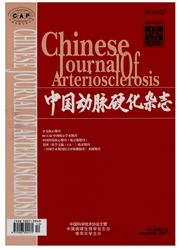

 中文摘要:
中文摘要:
目的 观察晚期糖基化终末产物(AGE)诱导的微血管内皮细胞核因子κB核转位,探讨氧化应激和内质网应激在核因子κB核转位中可能发挥的作用。方法 用AGE修饰的牛血清白蛋白(AGE-BSA)与人皮肤微血管内皮细胞(HDMEC)在体外共同培养1 h,设立对照组进行比较,用免疫荧光化学染色示核因子κB的核转位情况;应用活性氧的抑制剂谷胱甘肽(GSH)、NADPH氧化酶(NOX)抑制剂Apocynin、内皮细胞高表达的NOX亚型NOX4的siRNA和内质网应激的标志性蛋白内质网转膜蛋白激酶1α(IRE1α)的siRNA分别预处理细胞后再给予AGE-BSA刺激,观察核因子κB的核转位情况。结果 与对照组相比,AGE-BSA可诱导人皮肤微血管内皮细胞核因子κB入核;应用GSH、Apocynin、NOX4 siRNA和IRE1α siRNA预处理细胞均可抑制核因子κB的入核。结论 AGE对核因子κB的移位激活可能通过细胞内的氧化应激和内质网应激途径所介导。
 英文摘要:
英文摘要:
Aim To demonstrate the activation and nuclear translocation of the nuclear factor-κB(NF-κB) induced by advanced glycation end products (AGEs) in human dermal microvascular endothelial cells (HDMECs) , and to elucidate the roles of oxidative stress and endoplasmic reticulum stress in this pathological procedure. Methods HDMECs were incubated with AGEs-modified bovine serum albumin (AGE-BSA) at concentration of 100 mg/L for 1 h. As control, BSA of the same concentration was administered to HDMECs. NF-κB nuclear translocation was observed by immunofluorescent staining. Subsequently, HDMECs were pretreated with reduced glutathione (GSH), apocynin, a pharmacological inhibitor of NADPH oxidase (NOX), NOX4 siRNA or inositol requiring enzyme 1α (IRE1α) siRNA, and then administrated with AGE-BSA for 1 h. Changes of NF-κB nuclear translocation was observed. Results The results demonstrated the translocation of NF-κB from the cytoplasm to the nucleus upon the stimulation of AGE-BSA. Inhibition of reactive oxygen species generation with GSH or apocynin greatly attenuated these responses. Transfection of NOX4-small interfering RNA or IRE1α-small interfering RNA in HDMECs also significantly attenuated the AGE-induced translocation of NF-κB. Conclusion Oxidative stress and endoplasmic reticulum stress are possibly involved in the mediation of AGE-induced activation of NF-κB in endothelial cells.
 同期刊论文项目
同期刊论文项目
 同项目期刊论文
同项目期刊论文
 期刊信息
期刊信息
